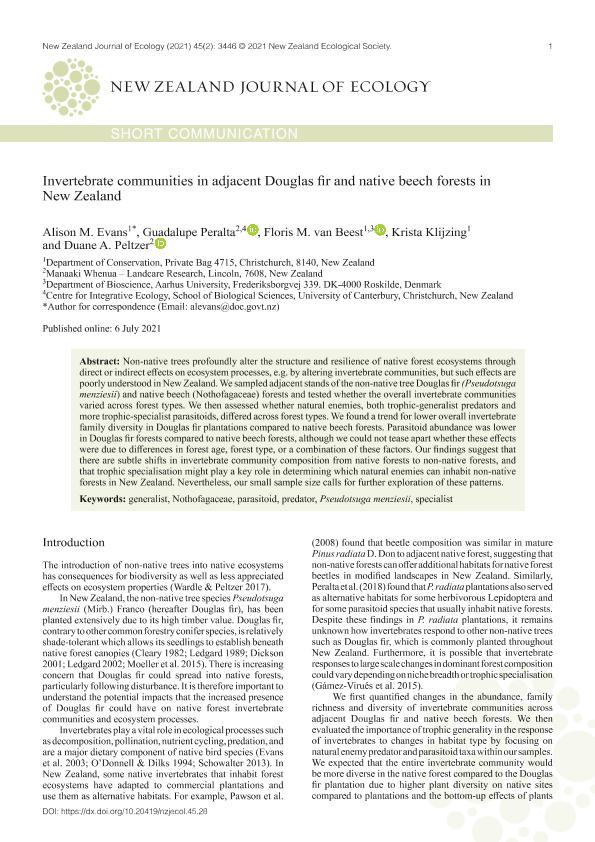Artículo
Invertebrate communities in adjacent Douglas fir and native beech forests in New Zealand
Fecha de publicación:
07/2021
Editorial:
New Zealand Ecol Soc
Revista:
New Zealand Journal Of Ecology
e-ISSN:
0110-6465
Idioma:
Inglés
Tipo de recurso:
Artículo publicado
Clasificación temática:
Resumen
Non-native trees profoundly alter the structure and resilience of native forest ecosystems through direct or indirect effects on ecosystem processes, e.g. by altering invertebrate communities, but such effects are poorly understood in New Zealand. We sampled adjacent stands of the non-native tree Douglas fir (Pseudotsuga menziesii) and native beech (Nothofagaceae) forests and tested whether the overall invertebrate communities varied across forest types. We then assessed whether natural enemies, both trophic-generalist predators and more trophic-specialist parasitoids, differed across forest types. We found a trend for lower overall invertebrate family diversity in Douglas fir plantations compared to native beech forests. Parasitoid abundance was lower in Douglas fir forests compared to native beech forests, although we could not tease apart whether these effects were due to differences in forest age, forest type, or a combination of these factors. Our findings suggest that there are subtle shifts in invertebrate community composition from native forests to non-native forests, and that trophic specialisation might play a key role in determining which natural enemies can inhabit non-native forests in New Zealand. Nevertheless, our small sample size calls for further exploration of these patterns.
Palabras clave:
GENERALIST
,
NOTHOFAGACEAE
,
PARASITOID
,
PREDATOR
,
PSEUDOTSUGA MENZIESII
,
SPECIALIST
Archivos asociados
Licencia
Identificadores
Colecciones
Articulos(IMBIV)
Articulos de INST.MULTIDISCIPL.DE BIOLOGIA VEGETAL (P)
Articulos de INST.MULTIDISCIPL.DE BIOLOGIA VEGETAL (P)
Citación
Evans, Alison M.; Peralta, Guadalupe; van Beest, Floris M.; Klijzing, Krista; Peltzer, Duane; Invertebrate communities in adjacent Douglas fir and native beech forests in New Zealand; New Zealand Ecol Soc; New Zealand Journal Of Ecology; 45; 2; 7-2021; 1-5
Compartir
Altmétricas




